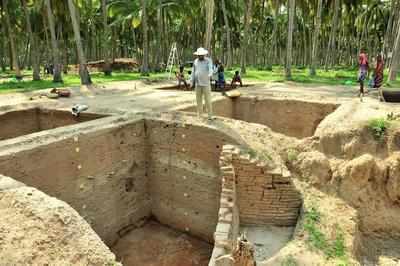
CHENNAI: Textile was an important craft of ancient India. The image of a male figure, identified as priest king, found at Mohenjo-Daro shows the vibrancy of weaving craft of ancient India. The outfit worn by the priest king has floral design on it.
Coming to Tamizhagam (today’s Tamil Nadu and its surrounding region), we have evidence of textile found at archaeological sites as well as in Tamil literature.
“The Sangam literature talks about clothes as thin as steam, and fine clothes resembling the skin of snakes. It mentions kalingam, aruvai, kazhagam as clothe varieties. Women preparing the cotton yarns and weaving in the night, and windows involved in weaving are mentioned,” said scholar V Selvakumar, professor, department of maritime history and marine archaeology of the Tamil University, Thanjavur.
Speaking on “The loom of Kamban” at a webinar on Saturday, Selvakumar said India had a vibrant weaving industry that was destroyed in the colonial times.
“India had supplied clothes across the world. The Coromandel coast became a centre of textile, catering to many markets. There are colonial documents presenting the rare textile samples of India,” he said
It is said that the weave of ancient Tamils was as intricate and poetic as Kamban’s words. The weavers of ancient Thamizhagam were experts in producing cloth as thin as a wisp of smoke.
“The weaves of Tamizhagam were greatly in demand as far away as Rome. They made clothes out of even the rat's hair. Weaving was next only to agricultural activity,” said Selvakumar.
The excavation at Kodumanal produced a piece of cotton cloth and spindle whorls used for making threads. Evidence for dyeing vat has been found at Arikamedu, Uraiyur and Keeladi.
Selvakumar said it’s high time we revived such a rich craft and introduced it commercially as part of the education and skill development system. “Efforts are needed to rediscover and apply traditional knowledge systems using a systematic and scientific approach,” he added.
Coming to Tamizhagam (today’s Tamil Nadu and its surrounding region), we have evidence of textile found at archaeological sites as well as in Tamil literature.
“The Sangam literature talks about clothes as thin as steam, and fine clothes resembling the skin of snakes. It mentions kalingam, aruvai, kazhagam as clothe varieties. Women preparing the cotton yarns and weaving in the night, and windows involved in weaving are mentioned,” said scholar V Selvakumar, professor, department of maritime history and marine archaeology of the Tamil University, Thanjavur.
Speaking on “The loom of Kamban” at a webinar on Saturday, Selvakumar said India had a vibrant weaving industry that was destroyed in the colonial times.
“India had supplied clothes across the world. The Coromandel coast became a centre of textile, catering to many markets. There are colonial documents presenting the rare textile samples of India,” he said
It is said that the weave of ancient Tamils was as intricate and poetic as Kamban’s words. The weavers of ancient Thamizhagam were experts in producing cloth as thin as a wisp of smoke.
“The weaves of Tamizhagam were greatly in demand as far away as Rome. They made clothes out of even the rat's hair. Weaving was next only to agricultural activity,” said Selvakumar.
The excavation at Kodumanal produced a piece of cotton cloth and spindle whorls used for making threads. Evidence for dyeing vat has been found at Arikamedu, Uraiyur and Keeladi.
Selvakumar said it’s high time we revived such a rich craft and introduced it commercially as part of the education and skill development system. “Efforts are needed to rediscover and apply traditional knowledge systems using a systematic and scientific approach,” he added.

Coronavirus outbreak
Trending Topics
LATEST VIDEOS
More from TOI
Navbharat Times
Featured Today in Travel
Get the app









